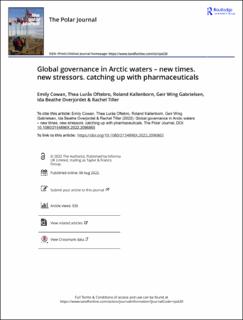| dc.contributor.author | Cowan, Emily Christine | |
| dc.contributor.author | Oftebro, Thea Lurås | |
| dc.contributor.author | Kallenborn, Roland | |
| dc.contributor.author | Gabrielsen, Geir Wing | |
| dc.contributor.author | Øverjordet, Ida Beathe | |
| dc.contributor.author | Tiller, Rachel Gjelsvik | |
| dc.date.accessioned | 2023-01-12T11:36:07Z | |
| dc.date.available | 2023-01-12T11:36:07Z | |
| dc.date.created | 2022-08-08T15:33:50Z | |
| dc.date.issued | 2022 | |
| dc.identifier.citation | The Polar Journal. 2022, . | en_US |
| dc.identifier.issn | 2154-896X | |
| dc.identifier.uri | https://hdl.handle.net/11250/3042993 | |
| dc.description.abstract | Arctic ecosystems are increasingly under pressure, not only from climatic stressors, resource extraction, and long-range transport of Persistent Organic Pollutants (POPs), but also from an increased use and subsequent release of Pharmaceuticals and Personal Care Products (PPCP). In Svalbard, an archipelago under Norwegian sovereignty in the High North, urbanisation and expanded tourism has exacerbated the issue of PPCPs accumulation in the region. The primary source of its release into aquatic ecosystems stems from untreated sewage and lack of Wastewater Treatment Plants (WWTPs). This study applies the research surrounding sources of hazardous bioaccumulation and examines mitigation alternatives for PPCPs within a governance framework since today, few regulations regarding human waste disposal are enforced in the Arctic. We held in-depth interviews and a participatory stakeholder workshop in Longyearbyen and Ny-Ålesund in 2021 to learn from experts about their perceptions of challenges, opportunities and synergies in terms of PPCP governance in Svalbard. This study found that overall, governance is servery lacking at all levels of analysis, from local to global, to prevent the harmful release of PPCPs in the waters and environment surrounding Svalbard. An inclusive approach with co-production of policy options is necessary to find a suite of solutions that will ensure that this new emerging environmental threat is handled so that Arctic biodiversity is protected against it. | en_US |
| dc.language.iso | eng | en_US |
| dc.publisher | Taylor & Francis | en_US |
| dc.rights | Navngivelse 4.0 Internasjonal | * |
| dc.rights.uri | http://creativecommons.org/licenses/by/4.0/deed.no | * |
| dc.subject | Biodiversitet | en_US |
| dc.subject | Biodiversity | en_US |
| dc.subject | Miljøgifter i Arktis | en_US |
| dc.subject | Environmental pollutants in the Arctic | en_US |
| dc.subject | Forurensing | en_US |
| dc.subject | Pollution | en_US |
| dc.subject | WWTPs | en_US |
| dc.subject | stakeholders | en_US |
| dc.subject | Svalbard | en_US |
| dc.subject | governance | en_US |
| dc.subject | Arctic ecosystems | en_US |
| dc.subject | PPCPs | en_US |
| dc.title | Global governance in Arctic waters – new times. new stressors. catching up with pharmaceuticals | en_US |
| dc.title.alternative | Global governance in Arctic waters – new times. new stressors. catching up with pharmaceuticals | en_US |
| dc.type | Peer reviewed | en_US |
| dc.type | Journal article | en_US |
| dc.description.version | publishedVersion | en_US |
| dc.rights.holder | © 2022 The Author(s). Published by Informa UK Limited, trading as Taylor & Francis Group. | en_US |
| dc.subject.nsi | VDP::Økotoksikologi: 489 | en_US |
| dc.subject.nsi | VDP::Eco-toxicology: 489 | en_US |
| dc.source.pagenumber | 20 | en_US |
| dc.source.journal | The Polar Journal | en_US |
| dc.identifier.doi | 10.1080/2154896X.2022.2096865 | |
| dc.identifier.cristin | 2041825 | |
| dc.relation.project | Norges forskningsråd: 315402 | en_US |
| dc.relation.project | Framsenteret: 534/752019 | en_US |
| cristin.ispublished | true | |
| cristin.fulltext | original | |
| cristin.qualitycode | 1 | |

